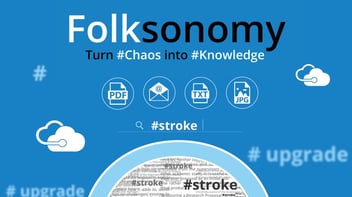Did you know 80% of business relevant information is in text form? These are the best text analytics systems to help you get insights.
Text analytics systems are all about helping you get high-quality information out of text inputs. It’s estimated that about 80% of information that’s relevant for a business comes from some sort of unstructured data, much of which is text - think things like e-mails, reports, and even social media posts.
Hidden inside this unstructured data is lots of valuable information, but without the technological tools to organize the data in some way, it can be very difficult to find it. That’s where text analytics come in.
What is Text Analytics?
Text analytics is a powerful tool that helps businesses extract valuable information from unstructured data. With around 80% of relevant business information being in the form of unstructured text, such as emails, reports, and social media posts, it can be challenging to uncover the insights hidden within. Text analytics systems are designed to organize and analyze this data, providing businesses with a deeper understanding of their text-based information. These systems vary in features and capabilities, but the goal remains the same: to help businesses make sense of their unstructured data.
Text analytics systems help you analyze your text-based data and sort it so you can understand the data. There are lots of text analytics systems, but not all of them are on equal footing. Many of them offer the different features and capabilities. Others provide powerful tools, but have a steep learning curve. And yet more are great programs, but may not quite fit your business needs.
When it comes to text analytics, there are a few concepts we should know: taxonomy, folksonomy, natural language processing (NLP) and large language models (LLM).
What is Natural Language Processing (NLP)?
Natural Language Processing (NLP) is a branch of artificial intelligence (AI) that deals with the interaction between computers and human language. It focuses on enabling computers to understand, interpret, and generate human language in a way that is both meaningful and useful.
The primary goal of NLP is to bridge the gap between human communication, which often involves unstructured and ambiguous language, and the structured and precise nature of computer languages. NLP enables machines to process, analyze, and derive insights from vast amounts of textual data, just as humans do.
What are Large Language Models (LLM)?
Large Language Models (LLM) are a class of artificial intelligence models that have the capability to understand and generate human language. These models are based on deep learning techniques and are trained on vast amounts of textual data to develop a profound understanding of language patterns and structures.
What is the difference between Taxonomy and Folksonomy?
-
Taxonomy is a hierarchical classification system where content is categorized into a structured and predefined set of categories. It follows a top-down approach, with categories and subcategories being predetermined by experts or administrators.
-
Folksonomy is a user-generated classification system where content is tagged and categorized by users themselves. It is a bottom-up approach, as users assign their own tags based on their understanding and context, without a predefined structure.
At Bismart we have our own text analytics solution. Folksonomy Text Analytics is an artificial intelligence software that analyses natural language text documents and locates the underlying information in unstructured data. Discover Folksonomy Text Analytics!
That’s why we’ve selected the 8 best text analytics systems that can help you get the information you need out of unstructured data.
The 8 Best Text Analytics Systems
SAS
SAS is a software tool that aims to help you get actionable insights from unstructured data, especially online content, ranging from books to comment forms. Because this software also lets you guide the machine learning process, you can narrow down automatically generated topics and rules. You can also see how the rules change over time, and thus refine your approach for better results.
QDA Miner’s WordStat
QDA Miner has a range of capabilities for analyzing qualitative data. For text analysis, the program uses the WordStat add-on module. The module is designed for content analysis, text analysis, and sentiment analysis. It can be used to analyze websites and social media, as well as for business intelligence. There are a few data visualization tools to help you better interpret the results from the program. WordStat’s correspondence analysis helps the program identify concepts and categories that are in your text.
Microsoft’s Cognitive Services suite
Cognitive Services offers a robust set of artificial intelligence tools that help you build intelligent apps with natural and contextual interaction. Rather than strictly a text analytics program, Cognitive Services incorporates elements of text analytics in how it analyzes speech and language. One of these is the Language Understanding intelligent service, which is designed to help bots and applications understand human input and communicate with people in natural language.
Rocket Enterprise Search and Text Analytics
Security is an essential concern for companies dealing with large amounts of data (Big Data), and Rocket’s tool takes this into account with their text analytic solution. Another feature of it is that it’s user-friendly, so teams can find the information they need quickly and easily. If you’re working with teams with limited technological experience, this tool can be very useful.

Voyant Tools
This application can be used by anyone as a text analytic tool for websites, though it tends to be popular for researchers in digital humanities. While not an in-depth text analytic system, Voyant Tools has a simple interface and the capabilities to do a variety of analytical tasks. In a matter of seconds, it can analyze a website and generate a data visualization in the text.
Watson
You may remember Watson as being the computer that famously beat Jeopardy! star Ken Jennings, so it may not be a surprise that IBM’s computer system has a top-notch text analytics system, too. It’s called Watson Natural Language Understanding, and uses cognitive technology to analyze text, which includes assessing sentiment and emotions.
Open Calais
Open Calais is a cloud-based tool that helps you tag content. This tool’s strong point is recognizing relationships between different entities in unstructured data, and organizing them accordingly. While it can’t do complex sentiment analysis, it can help you deal with unstructured data and turn it into a well-organized knowledge base.
Folksonomy Text Analytics
Bismart’s intelligent folksonomy software uses intelligent tags based on generative artificial intelligence (GAI) and Large Language Model (LLM) machine learning to sift through your unstructured data archives to locate specific information. This mean you no longer have to go through a long, tedious process of defining tags and categories. You can set up the program in different ways for different needs. You can also restructure it in real time for different uses. It’s fast, user-friendly, and with lots of different options, all of which makes it ideal for collaborative projects.
Want to know more about Folksonomy Text Analytics? Access all the information here:
In short, texts are a tool with great potential to obtain quality data so that we can make data-driven decisions.
Are you interested in finding out how we can transform your data into value? Contact us and our experts will help you find the right solution for your needs.




